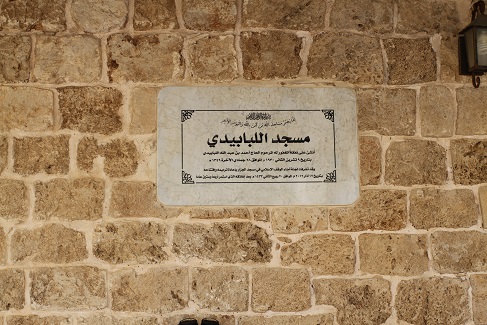




The Lababidi Mosque.
In 1930 Ahmad Lababidi, the son of a local wealthy Muslim family, constructed a new mosque as part of a private/family religious endowment (waqf Dhuri) in the emerging new modern suburb of Acre. This suburb is known in contemporary Acre as the ‘Mandatory City’. It was the first mosque to be constructed outside the historic city. A rectangular building of modest proportions (20x8 m.) was constructed from fine cut local stones in the midst of an open lot which are all part of the Lababidi endowment. One of the intriguing features of the mosque is the absence of a minaret. This 'omission' should be assigned to the high socioeconomic status and bourgeoisie characteristics of the new neighborhood that swayed the builder to maintain a low level of visibility. Following the dramatic events and aftermath of the 1948 war the mosque was closed and no religious activity took place therein. In the summer of 2005, the Department for Religious Sects in the Israeli Ministry of Interior initiated a limited renovation project of the Lababidi mosque. The restoration was confined to the external perimeters of the mosque and was initiated only as a response to a demolition order issued on the compound by the Acre municipal engineer. The emergency renovation of this small sized building instigated harsh and overly phobic responses among the Jewish citizens of Acre. The gist of these expressions of fear was that this act is part of an orchestrated campaign launched by the Arab citizens to "take over the city center". Early on in 2011 the Al-Jazzar Charitable Trust initiated a complete renovation of the mosque with the unconcealed intention to re-open the mosque and allow it to operate again after a latency period of 65 years:
“There was a need for a praying place for Muslims in the new city, indeed there was a need. It is not that I wanted to provoke someone. The mosque was already there in 1948 and I do understand the circumstances but what I do not understand is the situation in which the majority of the Muslim community lives outside the Old City, and we are not allowed to build anything. … Why must an old man who lives in the new city walk and pray in the Old City? I acted with no backup from any religious authorities and I did not ask for one. I wanted to act quietly and without any publication or provocation” (Salim Najami, interview, December 26, 2012).
On March 11, 2012 the mosque was inaugurated and the first prayer was preformed, the first since 1948. Since then more work was carried out mostly in its external perimeters and the embellishment of the courtyard. Our work follows the developments in and around the mosque and city since 2011 to the present.
Nimrod Luz
Read more (lecture in English)
Read more (lecture in Hebrew